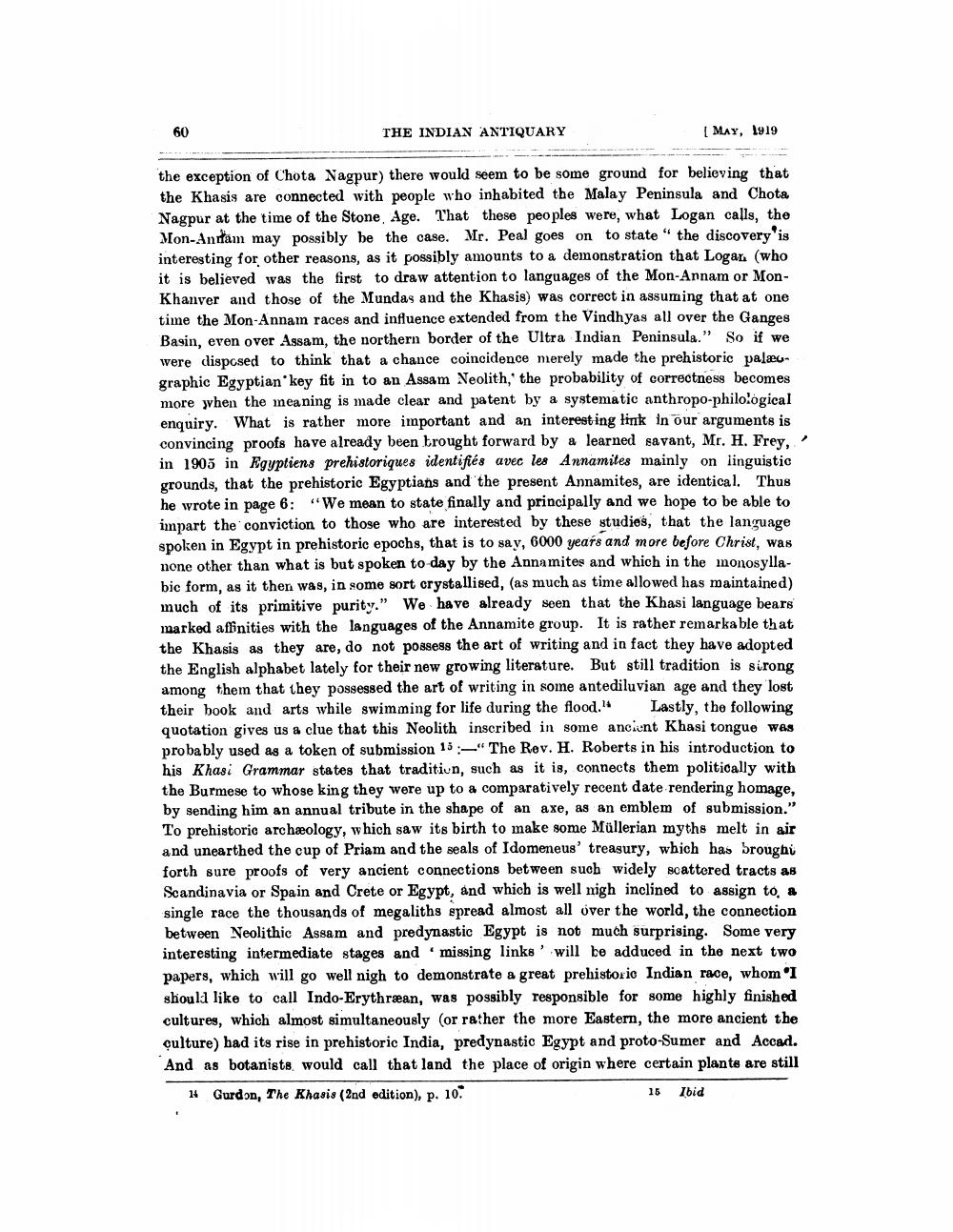________________
60
THE INDIAN ANTIQUARY
MAY, 1919
the exception of Chota Nagpur) there would seem to be some ground for believing that the Khasis are connected with people who inhabited the Malay Peninsula and Chota Nagpur at the time of the Stone Age. That these peoples were, what Logan calls, the Mon-Andam may possibly be the case. Mr. Peal goes on to state " the discovery'is interesting for other reasons, as it possibly amounts to a demonstration that Logar (who it is believed was the first to draw attention to languages of the Mon-Annam or MonKhanver and those of the Mundas and the Khasis) was correct in assuming that at one time the Mon-Annam races and influence extended from the Vindhyas all over the Ganges Basin, even over Assam, the northern border of the Ultra Indian Peninsula." So if we were disposed to think that a chance coincidence merely made the prehistoric palau graphic Egyptian'key fit in to an Assam Neolith, the probability of correctness becomes more when the meaning is made clear and patent by a systematic anthropo-philological enquiry. What is rather more important and an interesting link in our arguments is convincing proofs have already been trought forward by a learned savant, Mr. H. Frey, in 1905 in Egyptiens prehistoriques identifiés avec les Annamites mainly on linguistic grounds, that the prehistoric Egyptians and the present Annamites, are identical. Thus he wrote in page 6: "We mean to state finally and principally and we hope to be able to impart the conviction to those who are interested by these studies, that the language spoken in Egypt in prehistoric epochs, that is to say, 6000 years and more before Christ, was none other than what is but spoken to day by the Annamites and which in the monosyllabic form, as it then was, in some sort crystallised, (as much as time allowed has maintained) much of its primitive purity." We have already seen that the Khasi language bears marked affinities with the languages of the Annamite group. It is rather remarkable that the Khasis as they are, do not possess the art of writing and in fact they have adopted the English alphabet lately for their new growing literature. But still tradition is sirong among them that they possessed the art of writing in some antediluvian age and they lost their book and arts while swimming for life during the flood. Lastly, the following quotation gives us a clue that this Neolith inscribed in some ancient Khasi tongue was probably used as a token of submission 15 :-"The Rev. H. Roberts in his introduction to his Khasi Grammar states that traditivn, such as it is, connects them politically with the Burmese to whose king they were up to a comparatively recent date rendering homage, by sending him an annual tribute in the shape of an axe, as an emblem of submission." To prehistorie archæology, which saw its birth to make some Müllerian myths melt in air and unearthed the cup of Priam and the seals of Idomeneus' treasury, which has broughi forth sure proofs of very ancient connections between such widely scattered tracts as Scandinavia or Spain and Crete or Egypt, and which is well nigh inclined to assign to a single race the thousands of megaliths spread almost all over the world, the connection between Neolithic Assam and predynastic Egypt is not much surprising. Some very interesting intermediate stages and missing links' will be adduced in the next two papers, which will go well nigh to demonstrate a great prehistorio Indian race, whom 'I should like to call Indo-Erythræan, was possibly responsible for some highly finished cultures, which almost simultaneously (or rather the more Eastern, the more ancient the culture) had its rise in prehistoric India, predynastic Egypt and proto-Sumer and Accad. And as botanists would call that land the place of origin where certain plants are still 14 Gurdon, The Khasis (2nd edition), p. 10.
15 Ibid




